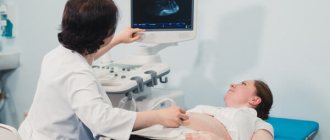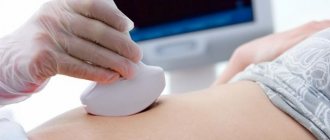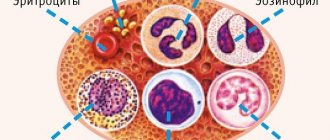What is blood taken for during the first screening?
A blood test is done to determine the level of substances such as β-hCG and PAPP-A. Beta-chorionic gonadotropin is important for the fetus in the early stages of development. Normally, the level of this hormonal substance increases and then gradually decreases.
Excessively high levels of β-hCG indicate the risk of Down syndrome. These indicators are also characteristic of early toxicosis, multiple pregnancy, and sugar toxicosis in the mother. If the level of beta-chorionic gonadotropin is below normal, pathologies such as:
- placental insufficiency;
- ectopic pregnancy;
- Edwards syndrome in the fetus.
Protein A is essential for the proper development and function of the placenta. An increased level of PAPP-A does not cause alarm, but a decreased level indicates a threat of spontaneous abortion and the development of de Lange and Down syndromes.
Features of the diagnostic procedure
The first screening examination will not show any visible abnormalities in the embryo, but will only conditionally identify the presence of intrauterine pathologies or the risk of having a child with abnormalities, including Down and de Lange syndromes.
Screening in the 1st trimester is not a mandatory procedure, but at 12 weeks it is prescribed to women at risk. Signs of being classified as such are:
- age – 35 years and older;
- genetic predisposition;
- viral infections;
- fetal pathologies, stillborn babies;
- consanguineous marriages;
- use of drugs, alcoholic beverages and medications;
- genetic abnormalities in born children;
- work associated with hazardous conditions.
In the absence of such indications, spouses can be examined at will.
Screening consists of several procedures:
- ultrasound examination of the fetus and placenta;
- biochemistry of blood from a vein.
Ultrasound determines body features, head size, blood supply to the baby, water volumes, bipaterial dimensions of the parietal tubercles, pathologies of the placenta, cervix, and uterine tone. If abnormalities in the development of the fetus are clearly visible during scanning, parents are informed about this, recommendations are given, approximate forecasts are made, and decisions are made on further actions.
During ultrasound scanning, transvaginal (inserted into the vagina) and transabdominal sensors (along the lower abdomen) are used. If necessary or as prescribed, Doppler sonography is performed. Ultrasound examination is a painless procedure.
During biochemical screening, hCG and protein levels are determined.
The results obtained are entered into the interface of a special software package, which calculates the numerical value of the risks of a particular pathology. In the transcript, this information is presented in the form of MoM - a coefficient indicating the deviation of the value of a particular characteristic in a given pregnant woman from the average, or normal.
Results are known within 24-48 hours. In public medical institutions, the period is extended to 20 days. Based on the results of the examination, doctors draw conclusions about the normal development of the fetus.
How to prepare for the examination
For screening to show the correct picture, it is necessary to properly prepare for the procedure.
Preparation for the first stage of perinatal examination consists of the following:
- hygiene of the external genitalia before ultrasound;
- easily removable clothing;
- You need to buy a diaper at the state clinic or take a towel from home;
- Do not urinate for two to three hours, or start drinking water for an hour and a half (mineral water with gases should not be consumed).
Blood for biochemistry is taken on an empty stomach or 6-8 hours after a meal.
If there is more than 7-8 hours between the ultrasound and the blood draw, you are allowed to eat a light breakfast.
First screening: what preparation is needed for donating blood?
Before donating blood for beta-human chorionic gonadotropin and protein-A, a number of conditions must be met. You should:
- give up intimacy in 2-3 days;
- the day before, exclude fatty meat, chocolate, and seafood from the menu;
- do not eat anything 6 hours before the test.
It is also important to be in a calm state, not to be nervous, and not to speed up your pace when walking. Stress and physical activity can cause an increase in the concentration of certain substances in the body, which will distort the test results.
1st trimester screening: importance of examination
- Some mothers underestimate the importance of the first screening and do not consider this examination mandatory.
The first screening is a highly informative study and allows you to identify a number of deviations from the norm:
- Deviations in the development of the neural tube
- Incorrect location of internal organs
- Control of chromosome set
- Syndromes of genetic origin
Very important
Questionable examination results are repeated in the near future in another medical institution. Screening in the 1st trimester of pregnancy allows you to minimize risks for the mother and her baby.
What should you not eat before your first blood screening?
2-3 days before the double test, you must adhere to a special diet. This is a very important requirement, since failure to comply will result in distorted results.
Before blood screening you need to avoid:
- fried and spiced foods;
- fatty meat;
- meat products (sausage, lard, bacon, smoked meats);
- canned food
Chocolate, nuts, chicken eggs, seafood, cabbage, rye bread, and legumes are also prohibited.
Cereals, butter and vegetable oil, pasta, honey, fresh and boiled vegetables are allowed. For meat dishes, boiled chicken is shown.
What other factors influence the results?
Screening results may be false for several reasons.
- Overweight or underweight during pregnancy. Hormone levels will deviate significantly from normal.
- Artificial insemination, IVF. To prepare a woman, large doses of medications are used, which distorts the hormonal picture.
- Multiple pregnancy. All indicators will be overestimated taking into account several fetuses in the uterus.
Diabetes mellitus may also affect screening results.
One of the important factors is the woman’s unstable mental state. The results will be distorted due to the release of hormones into the blood: cortisol and adrenaline.
Further actions
If the first screening turns out to be bad, i.e. its results show a high risk of developing pathologies, the pregnancy will be taken under special control. The woman will have to undergo additional diagnostics:
- consultation with a geneticist will be required;
- amniocentesis - study of amniotic fluid to clarify the diagnosis of chromosomal and gene pathologies;
- chorionic biopsy - the study of chorionic villi confirms or refutes the presence of hereditary or congenital diseases of the fetus;
- cordocentesis - umbilical cord blood analysis;
- mandatory second screening in the second trimester of pregnancy.
If the diagnosis is confirmed, depending on its severity and the possibility of correction, the doctor gives a recommendation for an abortion or prescribes treatment to eliminate the development of pathologies.
https://www.youtube.com/watch{q}v=lODqCvOrsZ8
If parents have any questions about the first screening that has already been carried out or has just been scheduled, they should definitely ask them to the specialist monitoring the pregnancy. After all, the peace of mind of the expectant mother is the key to the health of the pregnant baby.
Since the second screening during pregnancy is carried out already in the middle of pregnancy, abortion if severe genetic abnormalities are detected is impossible. What actions can the doctor recommend in this case? {q}
- Consult a gynecologist about the data obtained if the risk of developing abnormalities is 1:250 or 1:360.
- Carrying out invasive diagnostic techniques with a risk of pathologies of 1:100.
- If a diagnosis is confirmed that cannot be corrected therapeutically, artificial induction of labor and fetal extraction are recommended.
- If the pathology is reversible, treatment is prescribed.
The second screening quite often ends in forced labor, and the couple must be mentally prepared for this. Since a lot depends on these procedures, young parents need to know as much information as possible about them, which will help to understand unclear issues and dispel doubts.
If the first screening turns out to be bad, i.e. its results show a high risk of developing pathologies, the pregnancy will be taken under special control.
Fully or partially limited products
Before screening of the 1st and 2nd trimesters, smoked, fatty, spicy and fried foods, all dairy products, fish and red meat, meat and fish delicacies, canned food, chicken eggs, animal and cooking fat, nuts, carbonated and caffeinated drinks ( Pepsi, tea, coffee, cola), chocolate. Oranges, lemons, avocados, tangerines, and bananas are excluded from fruits. The consumption of legumes, cabbage, spices and seasonings, rye bread, and alcohol-containing drinks is not allowed.
Table of prohibited products
| Proteins, g | Fats, g | Carbohydrates, g | Calories, kcal | |
Vegetables and greens
legume vegetables 9.1 1.6 27.0 168 sauerkraut 1.8 0.1 4.4 19 white radish 1.4 0.0 4.1 21 celery (root) 1.3 0.3 6.5 32 horseradish 3.2 0.4 10.5 56 garlic 6.5 0.5 29.9 143 spinach 2.9 0.3 2.0 22 sorrel 1.5 0.3 2.9 19
Mushrooms
mushrooms 3.5 2.0 2.5 30
Nuts and dried fruits
nuts 15.0 40.0 20.0 500 dried fruits 2.3 0.6 68.2 286
Flour and pasta
dumplings 7.6 2.3 18.7 155 dumplings 11.9 12.4 29.0 275
Confectionery
cookies 7.5 11.8 74.9 417
Cakes
cake 4.4 23.4 45.2 407
Chocolate
chocolate 5.4 35.3 56.5 544
Raw materials and seasonings
seasonings 7.0 1.9 26.0 149 mustard 5.7 6.4 22.0 162 ginger 1.8 0.8 15.8 80 ketchup 1.8 1.0 22.2 93 mayonnaise 2.4 67, 0 3.9 627 ground black pepper 10.4 3.3 38.7 251 chili pepper 2.0 0.2 9.5 40
Dairy
fermented milk products 3.2 6.5 4.1 117 cream 35% (fat) 2.5 35.0 3.0 337
Cheeses and cottage cheese
cheese 24.1 29.5 0.3 363
Meat products
pork 16.0 21.6 0.0 259 lard 2.4 89.0 0.0 797 bacon 23.0 45.0 0.0 500 ham 22.6 20.9 0.0 279
Sausages
dry-dried sausage 24.1 38.3 1.0 455 sausages 10.1 31.6 1.9 332
Bird
fried chicken 26.0 12.0 0.0 210 smoked chicken 27.5 8.2 0.0 184 duck 16.5 61.2 0.0 346 goose 16.1 33.3 0.0 364
Fish and seafood
smoked fish 26.8 9.9 0.0 196 canned fish 17.5 2.0 0.0 88
Oils and fats
cooking fat 0.0 99.7 0.0 897
Alcoholic drinks
dry white wine 0.1 0.0 0.6 66 dry red wine 0.2 0.0 0.3 68 vodka 0.0 0.0 0.1 235 cognac 0.0 0.0 0.1 239 beer 0 .3 0.0 4.6 42
Standard values
When undergoing the first screening, special attention is paid to
the following
indicators
and
their compliance
with recommended standard values.
Patients are interested in when the first screening is done, and whether there is a time frame that allows them to delay or speed up testing. The timing is determined by the gynecologist leading the pregnancy. It is often prescribed from 10 to 13 weeks after conception.
. Despite the short duration of pregnancy, tests accurately show the presence of chromosomal disorders in the fetus.
Women at risk must be screened by week 13:
- who have reached 35 years of age;
- under 18 years of age;
- having a family history of genetic diseases;
- those who have previously experienced spontaneous abortion;
- who gave birth to children with genetic disorders;
- sick with an infectious disease after conception;
- having conceived a child from a relative.
Screening is prescribed for women who have had viral diseases in the first trimester. Often, not knowing what her position is, a pregnant woman is treated with conventional medications that negatively affect the development of the embryo.
If the screening results are alarming
First of all, in order to avoid unnecessary worry, you should not try to decipher the screening results yourself, based on data from the World Wide Web. The interpretation of screening results should only be carried out by your doctor, who will take into account the data from previous studies and many influencing factors. Thus, it is necessary to take into account the exact period, as well as the characteristics of the weight and height of the pregnant woman, the presence of genetic abnormalities in the family, chronic pathologies and other influences. If the screening results seem alarming to the doctor, you will undergo an additional examination, only after which certain conclusions can be made.
If the size of the fetus exceeds the standards, then the assumption is made that the pregnancy can end surgically. To make sure of this, an additional ultrasound will be prescribed a little later to assess the size of the birth canal and fetus and choose labor management tactics.
In late pregnancy, screening may also reveal problems with the location of the placenta or its attachment. This will also be a reason for additional ultrasound control. In these cases, it is needed to clarify the diagnosis and decide on a planned caesarean section. Identification of problems with the placenta during pregnancy (early aging, size discrepancy) will be the reason for additional CTG in order to exclude fetal hypoxia and carry out preventive treatment.
If pregnancy occurs against the background of problems in the circulatory system between the mother, placenta and fetus, this will be a reason for dynamic observation and hospitalization in a hospital for drug treatment. This will help improve the nutrition of the fetus and the delivery of oxygen to it. If screening reveals obvious abnormalities, a decision may be made about early delivery in order to preserve the life and health of the unborn child.
How is an ultrasound done?
The doctor who will plan the ultrasound procedure will tell you which type of diagnosis is preferable for you.
During the first trimester of pregnancy, ultrasound can be performed either abdominally or transvaginally.
The first method of undergoing an ultrasound is classic and is prescribed to most women bearing children.
Using this method, scanning the fetus and internal organs of a woman is carried out through the walls of the abdominal cavity.
The sonologist places the patient on a comfortable couch located near the ultrasound machine, lubricates her abdomen with a special gel that enhances the electrical conductivity factor of the skin, and begins to scan the abdomen, gradually assessing the condition of the fetus, placenta and uterus.
Transvaginal ultrasound is prescribed less frequently - in cases where the pregnancy is difficult.
The examination of the fetus, placenta and uterus of a woman is carried out using a special scanner inserted vaginally.
Both abdominal ultrasound and transvaginal ultrasound are completely painless procedures. The average time they take can range from twenty to forty minutes.
You only need to thoroughly prepare for an abdominal ultrasound. Before undergoing it, a pregnant woman should drink several glasses of clean, cool water (without gas).
This preparation will put additional stress on the bladder and allow doctors to more accurately examine the uterus.
Before visiting the clinic, prepare the items you will take with you to the ultrasound room. These include shoe covers, a diaper that you put on the couch, and a towel that you use to blot up excess gel.
If the diagnostic procedure is carried out transvaginally, then you will need to buy a special condom for ultrasound, in which the scanning sensor is placed.
On the day before the procedure, you can wash and use various care and hygiene products. Your doctor will likely tell you in advance what type of ultrasound you will have.
Choose the clothes that make you feel most comfortable. For an abdominal ultrasound, you will only have to bare your stomach, and for a transvaginal ultrasound, you will need to undress from the waist down.
How to prepare for the examination?
1st trimester screening includes ultrasound and biochemical blood test. Its main goal is the early detection of congenital pathologies of fetal development. Based on the examination results, doctors can assume that the child has chromosomal abnormalities such as Down, Edwards, Patau, and De Lange syndromes. You need to undergo screening from 11 to 14 weeks of pregnancy.
During the first screening, ultrasound is performed in 1 of 2 ways:
- Transvaginally. The sensor is inserted shallowly into the vagina.
- Transabdominal. The examination is done through the abdominal wall.
The first method is preferable because it allows you to get a clearer picture. The second method is used in the following cases:
- the patient is allergic to latex (since a latex condom is placed on the vaginal sensor);
- refusal of the expectant mother to undergo the procedure due to moral and religious beliefs.
When performing an ultrasound at 12-13 weeks, the specialist evaluates the site of attachment of the fertilized egg, as well as the following fetal parameters:
- size from coccyx to crown (KTR);
- characteristics of the nasal bone;
- thickness of the collar zone (TVZ);
- development of the brain hemispheres;
- head parameters (circumference, interparietal size (IPD), length from forehead to occiput);
- measurements of formed tubular bones;
- location and characteristics of internal organs;
- abdominal circumference.
Based on data on the physiological parameters of the fetus, the doctor makes a conclusion about the expected date of birth. If necessary, a specialist assesses the condition of the mother’s internal organs. The results of the study enable doctors to determine further tactics for pregnancy management.
If there are deviations from the norm, the specialist gives a referral for additional studies to confirm or refute possible chromosomal pathologies.
The first screening blood test involves determining the level of the hormone human chorionic gonadotropin (hCG) and pregnancy-associated plasma protein A (PAPP-A). Each gestation period corresponds to a certain level of these substances.
Activation of hCG production occurs at the moment of conception. By the presence of this hormone in the blood, the approximate duration of pregnancy can be determined. The hCG level also indicates possible genetic abnormalities of the fetus. However, assumptions about violations cannot be made only based on the indicators of this hormone. A cumulative comparison of hCG and PAPP-A has diagnostic value.
PAPP-A is a plasma protein that is produced by the outer layer of the embryo when it implants into the uterine cavity. This indicator during pregnancy is advisable only until the end of the first trimester, that is, up to 12 weeks. In the second trimester, the level of PAPP-A in all pregnant women is approximately the same. The purpose of studying this indicator in the early stages of pregnancy is to identify chromosomal abnormalities of the fetus.
In addition to child development disorders, analysis for hCG and PAPP-A reveals:
- threat of miscarriage;
- ectopic embryo attachment;
- death of the embryo.
Since during perinatal screening, ultrasound is performed first, if a missed abortion is detected, analysis for PAPP-A and hCG is not performed. However, in the case where a blood test indicates that fetal development has stopped, the diagnosis is confirmed by ultrasound examination.
For analysis, 10 ml of venous blood is taken from the pregnant woman. The laboratory uses the resulting serum. The most reliable result is obtained by studying fresh material, so the blood is examined within 24 hours after donation.
In order for the study to give the most accurate and reliable results, preparation for screening is necessary. Few people know how to prepare, so they make a number of mistakes, due to which there is a need to undergo diagnostics again. The very first thing a woman should consider is to refuse medications that were prescribed for other reasons.
Some medications may interfere with the results. If a woman has any chronic or systemic autoimmune diseases that require constant correction, additional consultation with a doctor is necessary. He will tell you individually which medications you will need to stay off for a day, and which you can continue to use, since they will not show up in your blood quality.
Doctors do not recommend having sex with a partner the day before you go for screening. Before the examination, as well as the day before the procedure, be sure to reduce physical and emotional stress. The woman should come to the examination rested and in a calm state.
It is necessary to take a bottle of water with you; it is likely that the doctor will want to additionally examine the woman’s genitourinary system and kidneys. You should drink water only after the doctor’s instructions; the procedure should be carried out strictly on an empty stomach; you should not eat at all. Is it possible to eat before screening? Absolutely all women who are preparing for tests are interested. It should be noted that the pre-screening diet is only required the first time so that the blood test is as accurate as possible.
When the second screening is done the evening before the study, a light dinner is allowed, possibly even with meat and fatty dishes, but in small quantities. It is important not to eat 4 hours before the test before screening. Returning to how to prepare for the first examination, and whether it is possible to eat heavy foods, it should be noted that there is a clear list of foods that doctors have allowed and which have been prohibited.
- Some mothers underestimate the importance of the first screening and do not consider this examination mandatory.
The first screening is a highly informative study and allows you to identify a number of deviations from the norm:
- Deviations in the development of the neural tube
- Incorrect location of internal organs
- Control of chromosome set
- Syndromes of genetic origin
Very important
Questionable examination results are repeated in the near future in another medical institution. Screening in the 1st trimester of pregnancy allows you to minimize risks for the mother and her baby.
The first screening is carried out between the 11th and 14th weeks of pregnancy. If the study is performed before this period, incorrect interpretation of the data is possible. The same applies to information received after the 14th week.
Getting ready for screening - 24 hour meal plan
In the morning you can have breakfast with oatmeal or buckwheat porridge cooked in water, along with slices of banana and pear. You can wash this whole thing down with freshly squeezed juice. At noon you should have a snack with low-fat yogurt or low-fat cottage cheese with strawberries. For lunch, lean vegetable soup or pureed zucchini soup with black or whole grain bread is perfect. Alternatively, cook pea soup or bean soup. For dinner, you can bake mushrooms in the oven and serve them with steamed broccoli and potatoes as a side dish. On this day you can drink tea without sugar, nibble crackers, drink freshly squeezed juices, eat vegetables and fruits in large quantities.
When preparing to become parents, couples are interested in the baby being born healthy, and they experience some worries about this. Doctors suggest undergoing procedures to determine norms and deviations. These procedures include screening. At what stage of pregnancy is it performed? What procedures are meant by the word “screening”? Should we be afraid of him? We will talk about all this in this article.
Conditions
The first screening is prescribed in the period from 10 to 13 weeks of pregnancy, the optimal option is 11–12 weeks, in order to minimize the possible error in calculating the timing and obtain an adequate result. The examination is recommended for all pregnant women. It includes:
- Ultrasonography. It can be carried out abdominally through the surface of the abdomen or transvaginally, using a special sensor.
- Biochemical screening is a laboratory biochemical blood test. A sample of approximately 10 milliliters of venous blood is taken.
The first ultrasound screening establishes a more accurate time of conception based on signs of fetal maturity, the place in the uterus where the fertilized egg is attached, the size and consistency of the placenta, determines multiple pregnancy, and fetal parameters.
The organs and systems formed by this time have their own indicators and characteristics of normal development. Subject to measurement:
- Characteristics of length - baby’s coccygeal-parietal size (CTR).
- The dimensions of the nasal bone are viewed and measured.
- The collar zone, its thickness, is of diagnostic interest.
- The hemispheres of the brain are compared, their symmetry, location and volume.
- The chambers of the heart, coronary vessels are determined, heart rate and the size of all cardiac structures are measured.
- Parameters of the fetal head: biparietal (interparietal) size, head circumference, area from the forehead to the back of the head (sagittal size).
- The length of the tubular bones of already formed limbs (thigh, lower leg, shoulder, forearm).
- Size of the abdomen, location and parameters of internal organs.
All measurements are compared with normal indicators for the corresponding period of development and analysis of the results for biochemistry and hormones.
The role of first screening ultrasound is invaluable in terms of pregnancy prospects. This instrumental research method shows gross anomalies when it is still possible to safely terminate a pathological pregnancy.
Laboratory research
Biochemical screening is an integral part of the first study complex. After receiving the ultrasound results, a venous blood sample is collected from the woman for the following tests:
- The first hormone produced during pregnancy (hCG - human chorionic gonadotropin). An increase or decrease in gonadotropin levels is an important clinical sign. Indicators of its concentration in an individual woman are compared with reference standards, which are tied to the timing of the week.
- For plasma protein A (PAPP-A), a protein produced by the placenta.
Test results and normal indicators are necessarily considered in relation to the deadline. Deviation from the standard norm can be a diagnostic sign only in combination with the interpretation of ultrasound.
If the processing of the data obtained characterizes the course of pregnancy as normal, then a negative result of the initial screening is given.
Anomaly detection is expressed on a scale of risk. If the degree is high, additional studies are prescribed.
They include repeated screenings in the second and third trimester of pregnancy, and, if necessary, more in-depth studies. The gynecologist may refer the pregnant woman for amniocentesis. This is a mini-operation to obtain amniotic fluid for detailed study, chorionic villus biopsy to clarify or remove the suspected diagnosis, cordocentesis (umbilical cord blood test).











